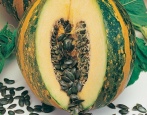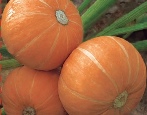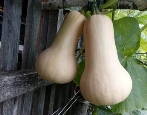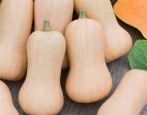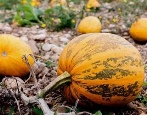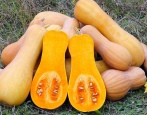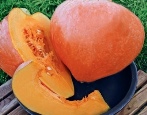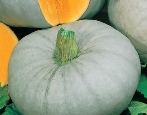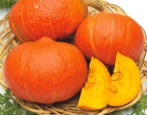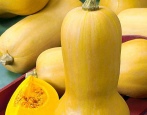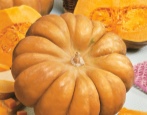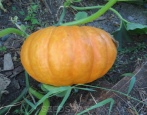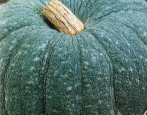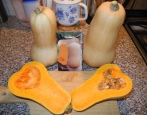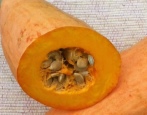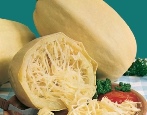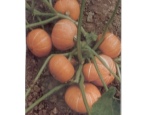
- Authors: Kushnereva V.P., Khimich G.A., Zharova V.P.
- Year of approval: 2008
- Leaf color: green
- The form: rounded
- Weight, kg: 1.2-1.8 (up to 3)
- Coloration: dark red with a pattern of green spots
- Bark: soft
- Color of the pulp: red-orange
- Pulp (consistency): crispy, dense, juicy
- Taste: sweet
The benefits of a beautiful and tasty culture from the pumpkin family are undeniable. Pumpkin serves as a decoration of the site, contains many useful elements and vitamins. There is a wide range of different categories, from decorative to food. The Sweetie variety is intended for cultivation in open ground and greenhouses, it is highly appreciated for its excellent taste and suitability for use in various forms.
Breeding history
The originators of the variety are breeders V.P. Kushnerev, G.A. Khimich, V.P. Zharova. Sweetie was registered in the State Register of Breeding Achievements in 2008.
Description of the variety
The candy has a high marketability, whose indicators are kept at the level of 100%, and many advantages.
The predominant qualities of the variety;
sweet taste;
rich vitamin and mineral content;
strong immunity and unpretentiousness in agricultural technology;
resistance to drought and short cold snaps;
long keeping quality, medium ripening times, attractive appearance and various uses.
As for the shortcomings, no indisputable ones have been identified. Of those that are noted by gardeners, it is possible to note the exactingness of the level of lighting and soil fertility, as well as the possibility of being affected by some types of diseases. However, these are standard requirements for the cultivation of cultivated plants, there are no absolutely protected from diseases.
Characteristics of the appearance of plants and fruits
The candy belongs to the annual varieties of the creeping type - the length of the lash is up to 1.5 meters. Spiny rough stems are covered with large (up to 25 cm) green heart-shaped leaves located on long petioles. The pumpkin blooms with attractive large flowers of bright yellow color. Segmented rounded fruit color: from bright orange to orange-red with dark green blotches.
The bark is soft, rough, easy to cut. The crispy, dense flesh has an intense orange-red color and a juicy texture. Elliptical small seeds are painted in whitish-cream tones, have a pleasant nutty flavor. The composition of the pulp: dry matter - 16.2-17.6%, sugar - 4.2-6.5%, carotene - 10.3-10.9 mg per 100 g of raw material. Storage duration: 90-120 days
Purpose and taste
The variety is characterized as universal, used for cooking preserves and jams, making juices, mashed potatoes, baby food. The pulp with increased sweetness and caramel notes is suitable for making candied fruits, sweets, baked goods, and can be eaten fresh. It is also good in cooking as mashed soups, side dishes, and various kinds of cereals. The chemical composition is rich in vitamins and macro-, microelements, it contains: sodium, phosphorus, magnesium, ascorbic acid and carotene. The candy is low in calories (22 kcal per 100 g) and is popular in overweight diets.
Ripening terms
The variety belongs to the mid-season category: from germination to harvesting, it takes from 115 to 120 days. Harvesting begins at the end of July and continues until the end of September.
Yield
Average yield indicators largely depend on the region of cultivation: in the Central region, they remove from 121 to 480 c / ha, in the Central Black Earth regions: 160-303 c / ha.
Growing regions
The variety is adapted for cultivation in the Central Region and the Central Black Earth Region.
Growing and caring
The candy is grown in several ways. This is direct sowing of seeds in open ground, growing in seedlings and in greenhouses. The optimal planting scheme is the distance between the holes 60 cm. The seeding depth is 5-10 cm. The pumpkin loves the sun, so they choose areas without signs of shading. Seeds for seedlings are planted in March-April - the exact numbers depend on the climatic characteristics of the region. Direct sowing is carried out after the threat of recurrent frosts has passed.
For seedlings, prepare a loose nutritious soil mixture with good air permeability and a neutral level of acidity. You can use ready-made universal primers. The seeds are immersed to a depth of 3-5 cm, the soil is moistened and placed in a warm, well-lit place. In the exhaust gas, they are planted in the presence of 3-4 true leaves. Pre-soaked and germinated seeds are sown in the garden.
The soil for planting should be loose and breathable, rich in humus and organic matter. Superphosphate, potassium fertilizers and ammonium nitrate, wood ash and coarse river sand are added to each well if the soil has a heavy clay structure.
Follow-up care consists of regular watering at the beginning of plant development. After each moistening, the soil must be loosened to avoid the formation of an earthen crust. Weeding will help clear the soil of competing weeds for nutrients. Both watering and weeding begin no earlier than a week and a half after planting. During this time, the seedlings will have time to take root and adapt. As a top dressing, an infusion of mullein or chicken manure is used, with a difference in consistency. With intensive growth of pumpkin, plantings are fed with ammonium nitrate for better development of the vegetative mass. The next feeding is carried out after 3 weeks. From about the middle of summer, when the foliage is closed by an impenetrable cover, irrigation, weeding and feeding can be stopped.
The first ripe pumpkins appear in the middle of summer or towards the end of July. It is advisable to harvest the crop on a sunny day, leaving the stalk at least 10 centimeters long. When laying for long-term storage, pumpkins are laid in such a way that they do not come into contact with each other and other objects. It is better to store in a cool room - vegetable store or basement.
Requirements for soil and climatic conditions
The candy is adapted for warm black earth regions, but it is able to grow and bear fruit in a more temperate climate: middle lane, North-West region. This is due to its excellent cold-resistant properties. In the presence of a long summer period, up to 7-8 fruits can ripen on one lash, however, even with a shortened summer season, you can get up to three sweet fragrant pumpkins from one stem. If you use the seedling method of growing in greenhouses, then the indicator can be significantly increased.
Disease and pest resistance
For the variety, such diseases traditional for this culture as bacteriosis and white rot, powdery mildew and root rot are dangerous. However, these symptoms appear only in the initial period of development and under unfavorable conditions: prolonged cold snap, rainy summer. Preventive fungicide treatments will help to avoid troubles. Of the insect pests, the spider mite loves culture.
Risks can be prevented with insecticides and crop rotation. Pumpkin should not be planted after related crops: squash, zucchini, cucumbers. But onions, beans, potatoes and other root crops are wonderful predecessors that do not pose a threat of soil contamination with pathogens of common diseases.
